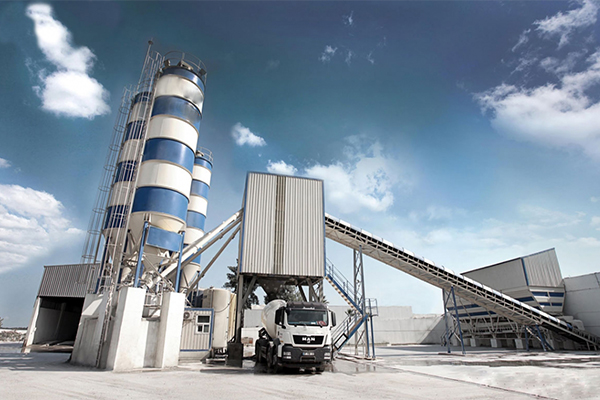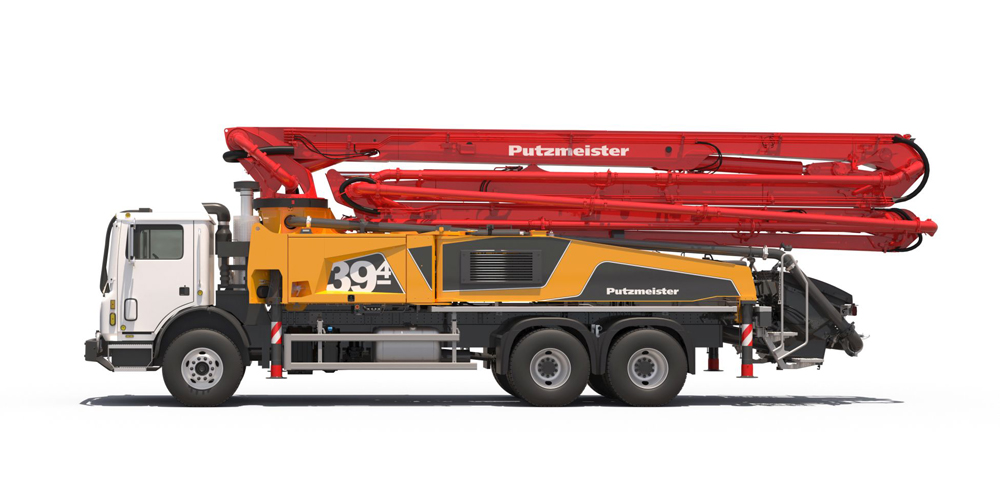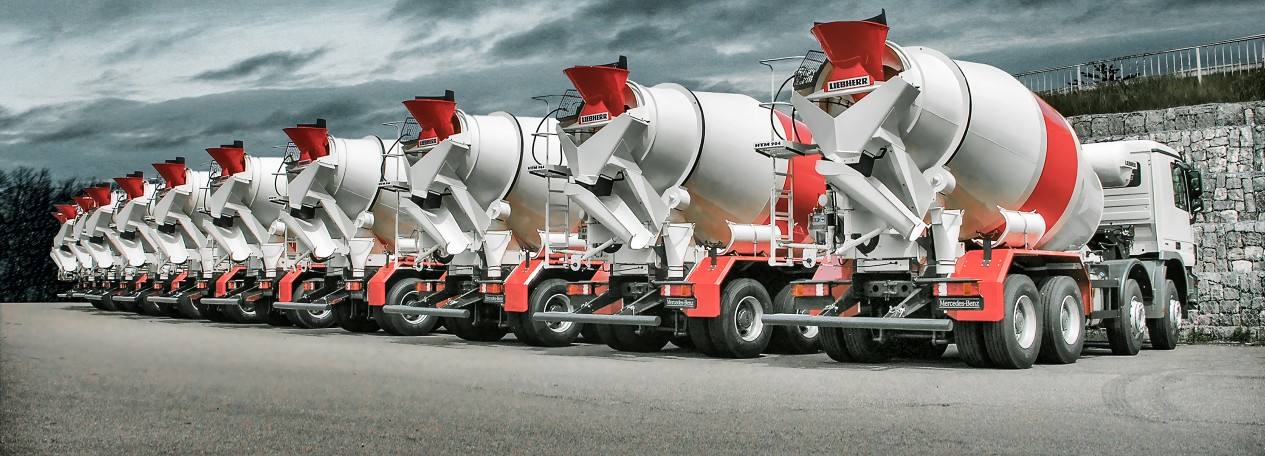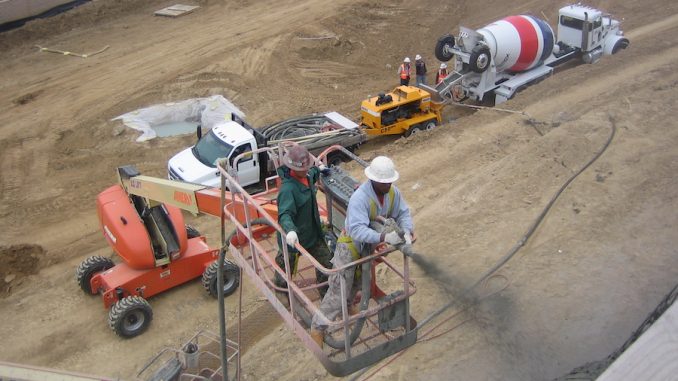10 types of equipment for concrete production
Concreting is one of highly-labor consuming and resource-intensive processes in the construction industry. It is impossible to work without additional equipment, if we consider large-scale projects. It is necessary to use a number of different concrete equipment to ensure each stage from production to leveling poured mixture.
The use of equipment not only automates the working process with concrete, but also optimizes all resource costs: time, labor, economic.

Concrete equipment is divided into several types according to work stage:
- concrete mix preparation (batchers, concrete mixers, mortar mixers);
- transportation/delivery of concrete mix (batching plants, concrete haulers);
- supply, distribution and placement of concrete mix (concrete pumps, concrete pump truck, concrete buckets, concrete screeds);
- compaction of concrete mix (concrete vibrators);
- specialized tooling (concrete spreading and concrete trim).
Let’s review the most common concrete construction equipment around the world.
Batching plants
This variety of equipment produces concrete mix from various components: fine and coarse aggregate, cement, water and other substances and additives required to obtain necessary mortar grade.
There are several types of equipment for concrete production:
- Cement-mixer
It is typically applied for small-scale, private construction, where insignificant concrete mix volume or other mortars are needed. It is used in residential construction, small projects, concrete driveway, pavement, and sidewalks in a private area (varying in volume from 0.5 to 3 cubic yards).
- Stationary batching plant
This is a whole equipment set, which fully ensures concrete mortar production at every stage:
- loading and unloading conveyors for adding all mortar components;
- dosing machines;
- mixers for blending components;
- control panel, where the entire production process is regulated.

Stationary batching plants have the highest capacity of all concrete mixing equipment. They can produce from 30 to 350 cubic yards per hour. Equipment can provide concrete for several construction sites at once. However, special conditions are needed to operate it.
Stationary batching plant requires a large area at which all equipment set can be placed. Transporting and installing all parts can take several days before starting to produce concrete. Also, installation needs to comply with state and federal laws
This type of concrete plant needs not only equipment, but also specialists (who will regulate operation and monitor production process) and additional techniques.
- Mobile batching plant
The equipment differs from stationary plants in compactness and mobility, however, it is also a complex equipment for making a mixture.
Installations of this type produce up to 200 cubic yards of concrete per hour. It is possible to disassemble and transport the equipment to another site at the end of construction project. Assembly and disassembly take a long time, unlike stationary plants, work is carried out without welding.
- Self-loading concrete mixers
This type of equipment is very different from others by its design. It is a hybrid of a mixer truck and a front-end loader.
Special-purpose machinery fully automates the process of production from loading to unloading concrete mix on site:
- moves independently around the site and over short distances with the help of all-terrain wheels
- loads all components into mixing drum using a bucket
- integrated pump supplies water to drum
- drum kneads concrete while mixer is driving to site
Approximately 4 to 15 workers are needed to operate mobile and stationary concrete batching plants and regulate manufacturing process then deliver mixture to the site. Concrete mixer only needs one operator and two people to load cement if it is in 94 lb bags. Operator controls the entire concrete production process from the driver’s cab.

Functionality of this equipment does not end with this description. Carmix models are hybrid machines.
Concrete mixers are highly cross-country capable due to all-terrain wheels, hydrostatic transmission, and all 4 swivel wheels. They can go off-road, get over a 30° slope and drive to hard to reach areas where concreting is difficult.
Their capacity ranges from 1.3 to 7.2 cubic yards per production cycle, which takes 20-30 minutes. Different models can produce an average of 5.2 to 16 cubic yards of concrete per hour.
You can easily monitor concrete quality with Carmix. Self-loading concrete mixers have a built-in weighing system which displays the weight of each loaded component.
Concrete pumps
This type of equipment is needed to deliver concrete over a long distance, when it is impossible to bring construction material to the site of pouring by mixer. Concrete pumps are used for construction in mountains, high-rise buildings or in confined spaces (mines and tunnels)
Concrete pumps can be divided into two types:
- Stationary concrete pump
The equipment is attached to a truck or mounted on a trailer and the concrete is pumped through rubber hoses or steel piping. Working with a stationary pump requires that the outlet of the piping be directed to a specific area where the concrete needs to be delivered.
Stationary concrete pumps are large in size, so they are not very maneuverable. The plants do not move around the site and sit in optimal place for mixture supply. This drawback is compensated by the fact that the concrete pipeline from the pump can extend for long distances. This advantage allows concrete to be fed several dozen feet from the pump itself. It is easy to provide mortar for construction of high-rise structures that do not require moving machinery around the site with this type of equipment
The maximum possible output for a stationary type of concrete pump is up to 210 cubic yards per hour.
- Mobile concrete pump
Compactness is the main difference and advantage of mobile concrete pumps over the above-mentioned types.

The equipment can be easily moved around the construction site without much effort due to its overall dimensions. Most models of this type are connected to a tractor using a trailer, and then you can move it to the distance you need or transport it to another construction site.
Its size also allows it to be mobile even on sites with limited space or in cramped conditions (construction in the mountains, where space is limited by cliffs and rocks).
Compactness and other features are sometimes more necessary on a construction site than high performance.
Carmix Pump, for example, is half the size of stationary concrete pumps:
Width – 4ft 11in
Length – 13ft 5in
Height – 5ft 1in
Weight – 3,417 lbs (1.55 tons)
This type of equipment can pump up to 20 cubic yards of concrete mortar per hour and deliver it 300 feet high and 500 feet away.
The lower capacity is compensated for by Carmix’s maneuverability. Equipment remains fast and easy to move around your site when a stationary concrete pump is less mobile because of its size.
Mixers for transporting concrete
Concrete mixers are used to transport concrete to the site or from the concrete plant to the pouring area
The machines can transport concrete over long distances in a drum, which continuously blends the mixture. The concrete does not begin the curing process and can remain in a liquid state in the mixer for up to 1-1.5 hours due to constant rotation.
1-1.5 hours is the average index at a temperature of 68°F without addition of various chemicals. Many factors affect the transport duration (from mixture components type to weather conditions).

Concrete mixers are divided into two types:
- which are engaged in delivery of ready-mixed concrete (they are loaded with already kneaded mixture in liquid form).
- which independently produce mixture on site.
(such concrete mixers differ in configuration in that they have separate tanks with water).
Dry mixture of required components is loaded into mixing drum. Then machine unloads water from tanks directly into mixing drum, where concrete production completes.
This means concrete does not lose its quality during transportation, as the main reaction of components takes place before concreting itself.
Concrete vibrators
Many microscopic air bubbles form in the mortar when concrete mixture has already been poured into formwork. This air causes cavities inside the structure during setting and premature cracking during operation.
Vibrating equipment allows you to get rid of excess air in poured mortar, compact concrete and distribute it to all the edges of formwork.
Vibrations are caused either by reciprocating directed movement of mass, or by rotation of unbalanced mass fixed on the shaft.
Concrete vibration applications can be divided into three main categories:
- Formwork vibration
Formwork vibration is commonly used in precast concrete structures and involves placing vibrators outside concrete forms. External formwork vibrators are often spaced 6 feet apart for larger concrete objects.
- Surface Vibration
Large concrete vibrators are guided manually to surface of poured concrete. This method is limited to a slab thickness of about 6 inches or less, but it provides a smooth surface, which is desirable when the appearance of the structure is important.

- Internal Vibrating
Internal vibration equipment is the most commonly used. One operator will be enough to work with it. The process is simple: a worker quickly pushes an internal concrete vibrator (similar to a probe) into the wet concrete and then slowly extracts it.
Concrete pavers
This equipment is used in works related to laying, compaction of concrete pavement. Pavers are used for several tasks: in production of precast and reinforced concrete products and in road construction.
It is used for laying airfield runways, floors in buildings, roads and sidewalks. There are only a few varieties since the specificity of equipment use is narrowly focused.
Telescopic. It is equipped with a telescopic boom. At the end of the boom is a rail and an auger, which distribute the mixture, and a shaving beam, which compacts concrete.
Non-telescopic. Paver rides on the already unloaded concrete, moves forward with lowered element, which levels mixture.
Manual. It requires several people who manually move it.
Torquette devices
Pavers apply liquid and dry mortars to the building surface by spraying. Concrete or dry mixture components are placed in a special container. A drum metering device feeds the substances to the mixing nozzle. Compressed air is fed to this element and they all are mixed with water to form a working mortar. Thanks to such conditions, mixture adheres well to any base surface.
Shotcreting allows to make concrete structure as strong as possible. Therefore, such a method and technique is used in tunnel construction, hydraulic structures, overpasses, soil strengthening, structural repair and so on (wherever high concrete strength is required because of an aggressive external environment).
Shotcrete equipment can be used with dry components or wet concrete. Dry application is suitable when a process entails multiple stops throughout the entire application.

Wet-mix shotcreting has become more common than dry shotcrete because of less rebound and less dust. This process allows large volumes to be placed in less time. This is an advantage.
Concrete crushers
Almost all of equipment here is needed for building of new concrete objects. However, crushers are used to demolish old structures or poorly concreted areas.
The main task of crushing equipment for concrete is to recycle waste after demolition of buildings.
Objects (which are to be demolished) contain high-quality components for mortars. Throwing them away is a waste of resources, so they are recycled with concrete crushers and are added to new mixes.
Concrete conveyors
It is a type of conveyor belt that transports concrete horizontally or vertically (over limited distances). This type of conveyor is less expensive and can reduce the need for cranes and other similar equipment.
Concrete conveyors are ideal for large projects such as dams and power plants because of their capacity. They also allow companies to save on labor costs because only a few people are needed for a job.
Concrete supply container
It is a reservoir used to feed mixture in high-rise construction.
It consists of a hopper (where the mortar is poured), a slide valve (which ensures an even flow of the mixture), a handle, locks and transport loops (by which the crane is secured before lifting the container to the top).
Any mortars up to 5 cubic yards can be lifted to a height except for quick-setting mixtures.
Such equipment is used for concreting high or difficult to access objects.
Polish equipment
When the concrete mixture is poured and vibrated, removing excess air, the surface of the site is still uneven. Therefore, the surface should be treated with special equipment for polishing and floating.
Concrete surface finisher – equipment that involves the final finishing of concrete construction. Such equipment does not differ from each other in structure: a motor is attached to a frame, which rotates the polishing blades or disk. Surface floating takes place with the help of rotating blades.
Concrete surface finishers work on the principle of lawnmower. It is possible to divide it only by engine type: electric or gasoline. Combustion engine equipment is more powerful, nevertheless concrete surface finisher with an electric engine allows it to work indoors without harmful emissions.

